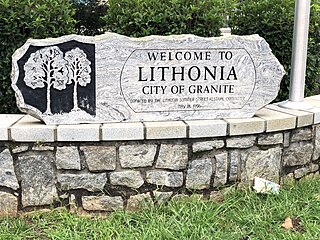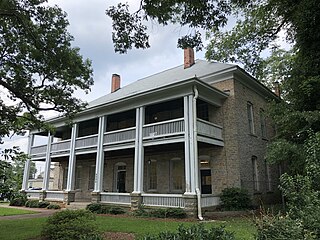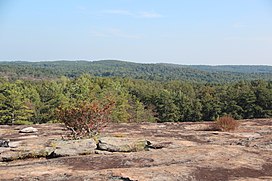
DeKalb County is located in the north central portion of the U.S. state of Georgia. As of the 2020 census, the population was 764,382, making it Georgia's fourth-most populous county. Its county seat is Decatur.

Lithonia is a city in eastern DeKalb County, Georgia, United States. The city's population was 2,662 at the 2020 census. Lithonia is in the Atlanta metropolitan area.

Redan is a census-designated place (CDP) in DeKalb County, Georgia, United States. As of the 2020 census, the CDP had a total population of 31,749. It is a predominantly African American community in eastern DeKalb County, and is a suburb of Atlanta.

Stone Mountain is a city in DeKalb County, Georgia, United States. The population was 6,703 according to the 2020 US Census. Stone Mountain is in the eastern part of DeKalb County and is a suburb of Atlanta that encompasses nearly 1.7 square miles. It lies near and touches the western base of the geological formation of the same name. Locals often call the city "Stone Mountain Village" to distinguish it from the larger unincorporated area traditionally considered Stone Mountain and Stone Mountain Park.

Stone Mountain is a quartz monzonite dome monadnock and the site of Stone Mountain Park, 16 miles (26 km) east of Atlanta, Georgia. Outside the park is the small city of Stone Mountain, Georgia. The park is the most visited tourist site in the state of Georgia.

Panola Mountain is a 100-acre (40 ha) granite monadnock near Stockbridge on the boundary between Henry County and Rockdale County, Georgia. The peak is 946 feet (288 m) above sea level, rising 260 feet (79 m) above the South River. The South River marks the boundary between Henry, Rockdale, and DeKalb counties. Due to its delicate ecological features, Panola Mountain was designated a National Natural Landmark in 1980.
The Atlanta, Stone Mountain and Lithonia Railway (ASM&L) was a rock quarry railroad that began operations in 1909. A "common carrier" railroad it had lines connecting to the Georgia Railroad and primarily served granite and gneiss quarries at Lithonia and at Stone Mountain in DeKalb County. It operated 4 miles of track from Lithonia, Georgia, to a quarry near Rock Chapel, Georgia.

Kensington is an at-grade train station in unincorporated DeKalb County, Georgia, serving the Blue Line of the Metropolitan Atlanta Rapid Transit Authority (MARTA) rail system. It has one island platform with 1 track on each side. This station opened on June 26, 1993.
The DeKalb County School District (DCSD) is a school district headquartered at 1701 Mountain Industrial Boulevard in unincorporated DeKalb County, Georgia, United States, near Stone Mountain and in the Atlanta metropolitan area. DCSD operates public schools in areas of DeKalb County that are not within the city limits of Atlanta and Decatur. It will serve a portion of Atlanta annexed by that city in 2018 until 2024, when that portion will be re-assigned to Atlanta Public Schools (APS).

The Mall at Stonecrest is a super regional shopping mall along Interstate 20 in eastern Metro Atlanta that opened in 2001 on the growing I-20 corridor. It is off exit 75 in Stonecrest, Georgia, which became a city in 2017.

Isoetes melanospora, commonly known as black-spored quillwort or black-spored Merlin's grass, is a rare and endangered aquatic lycophyte endemic to the U.S. states of Georgia and South Carolina. It grows exclusively in shallow, temporary pools on granite outcrops, often with only 2 cm of soil. 11 populations are known to exist in Georgia, while only one has been recorded in South Carolina, though this population is believed to be extirpated. The number of sites has dropped from 18 following its discovery due to habitat destruction caused by quarrying, trash dumping and trampling. New leaves quickly sprout after fall and winter rains, but during the dry summer months these typically shrivel.

Alcovy Mountain is a monadnock in the U.S. state of Georgia similar to Kennesaw Mountain in the city of Marietta. It is located in Walton County four miles south of the city of Monroe. With a summit elevation of 1,128 ft (344 m), the mountain is the highest point in Walton County, and is the southeastern-most mountain of significance in the Appalachians.

Gratiola amphiantha is a rare species of flowering plant known by the common names little amphianthus, pool sprite and snorkelwort. It was previously the only species in the monotypic genus Amphianthus, but it was moved to genus Gratiola after genetic analysis in 2008. It is native to the Piedmont region of the southeastern United States, with a center of distribution in Georgia. It occurs in Alabama and South Carolina as well. It is limited to granite outcrops, a high-biodiversity habitat type that is threatened by activities such as quarrying, off-road vehicles, and trash and debris dumping. It is a federally listed threatened species.
The Arabia Mountain Path (AMP) is a paved biking and hiking trail connecting sites within the Arabia Mountain National Heritage Area, built by the PATH Foundation. The trail covers more than 30 linear miles and features hills, sections of boardwalk, a serpentine bridge, and access to 13 free trail head parking areas. The AMP connects a number of visitor destinations and recreational areas including Panola Mountain State Park, the Monastery of the Holy Spirit, Davidson-Arabia Mountain Nature Preserve, the Mall at Stonecrest, and historic Lithonia, Georgia.
Flat Rock is a historic African American community in DeKalb County, Georgia. It is located within the city of Stonecrest, as well as the Arabia Mountain National Heritage Area. Flat Rock is believed to be one of the oldest African American settlements in DeKalb County. In 1820, the area rested along the border of Creek and Cherokee Nation hunting grounds when it was settled during the Georgia Land Lottery. In 1865, after the end of the Civil War, the era of reconstruction provided opportunity for former enslaved people to stay in the area to build schools, churches, and civic organizations and create the tight knit African American Flat Rock Community. The community has continued to live in the area and have experienced the Black Codes, Jim Crow and the Great Migration. The area currently houses the Flat Rock Archives, which specialize in preserving African American rural history in Georgia.

Stonecrest is a city in DeKalb County, Georgia, United States. The boundaries of the city generally lie in the far southeastern corner of the county, and a smaller portion just north of Interstate 20. The city borders the existing municipality of Lithonia, as well as Rockdale and Henry counties.

The Seminary is a historic building at 6886 Main Street in Lithonia, Georgia. Originally constructed as a school in 1895, over the years it has also served as a hotel and a private home. It is currently used as a multi-tenant office building. It was entered into the National Register of Historic Places (NRHP) on November 15, 1978.

Heggie's Rock is a large granite outcropping in Columbia County, Georgia, United States. Declared a National Natural Landmark in 1980, the property was purchased by The Nature Conservancy in 1983.

The Flat Rock Archives is an African American historical museum located in the city of Stonecrest, Georgia. The mission of the archive is to preserve rural African American history in Georgia. The archive is located in a historic home built by T.A. Bryant, Sr., and was donated in 2005, by Rev. T.A. Bryant, Jr. and his sister, Zudia Guthrie, to preserve and store all the Flat Rock records and documents. It was established as a museum and resource to genealogical and historic research, as well as a heritage tourism site. The Flat Rock Archives consists of a variety of historic sites including the Flat Rock African American Historic Cemetery. All of these sites are located within the Arabia Mountain National Heritage Area. See Flat Rock, Georgia to learn more about the history of this area.





















